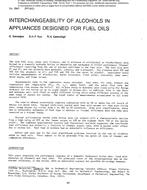Description
Two pure fuel oils, three pure alcohols, and 14 mixtures of oil/alcohol or alcohol/water were burned in a domestic hydronic boiler to determine the influence on boiler performance (thermal efficiency) resulting from the use of alcohol additions to the fuel oils. The fuel oils were #1 and #2, and the alcohols were methanol, ethanol, and n-propanol. The mixtures were 20% and 50% far the alcohols in oil, and 10% and 30% for the water in alcohol. Associated tests included measurements of miscibility, water tolerance, flash point, viscosity, pump wear, spray angle, and flame volume.
Measurements made in the combustion tests included: fuel rate, air rate, exhaust gas temperature and composition (CO2, CO, 02), smoke level, and the water flow rate and temperature rise across the boiler. All 19 pure fuels or mixtures were fired using the design atomizer for the burner at up to eight levels of excess air; in addition, five of the fuels and mixtures were each fired at eight different firing rates using different nozzles at the same range of excess air levels. The total number of measurements accumulated in all tests exceeded 4000.
The results showed essentially complete combustion with no CO or smoke for all levels of excess air above zero. Thermal efficiency varied much less with excess air than with firing rate, using excess air values from 0 to 20% in 5% intervals . Even more significantly, there was no detectable influence of fuel type or mixture on thermal efficiency when the data were compared on a thermal basis.
Thermal efficiencies varied with firing rate (or output) with a characteristic decline from a high value of 82% at the lowest output to 65% at the highest (with M at the design point). The combined experimental results and theoretical analysis supported the conclusion that efficiency was primarily a function of thermal supply rate, with a second order effect due to excess air . Fuel type or mixture had no detectable influence on efficiency.
Safety and cost may be the most significant problems involved in the use of alcohols added to fuel oils. There appear to be no problems from the point of view of thermal and combustion efficiency.
Units:
Citation: ASHRAE Transactions, 1986, vol. 92, pt. 1A, San Francisco
Product Details
- Published:
- 1986
- Number of Pages:
- 17
- File Size:
- 1 file , 1.7 MB
- Product Code(s):
- D-SF-86-2947




